|
Although Kamil Hornoch uses his 35 cm
(approx. 13.8 inch) f/4.7 Newtonian
telescope primarily for comet photometry and for hunting novae in M31
galaxy, using of CCD camera with integrated filter wheel and LRGB
filters installed encouraged him to try to shot some deep sky wonders.
Here are some example images.
M1 Crab Nebula
M1 is the expanding cloud of gas (known as “Crab
Nebula”), created when the star exploded as supernova. The
explosion was observed in the year 1054 AD. The M1 nebula is
6,000 light years apart.
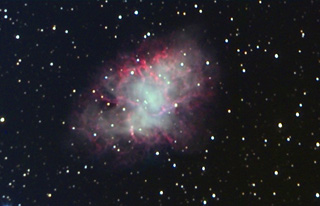
M1 “Crab Nebula”
| Date |
January 24th, 2006 |
| Filter |
Exposure |
Binning |
| Clear |
50 min |
1 × 1 |
| Red |
20 min |
2 × 2 |
| Green |
20 min |
2 × 2 |
| Blue |
25 min |
2 × 2 |
M3
Almost million of stars at a distance of about 33,900 light
years packed at a sphere approximately 180 light years across form
a beautiful globular cluster marked M3.
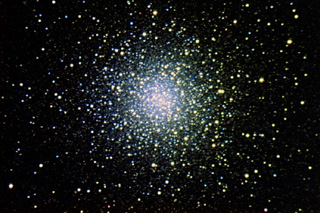
M3 globular cluster
| Date |
January 25th, 2006 |
| Filter |
Exposure |
Binning |
| Clear |
5.5 min |
1 × 1 |
| Red |
5 min |
2 × 2 |
| Green |
8.5 min |
2 × 2 |
| Blue |
12.5 min |
2 × 2 |
M13 Hercules Globular Cluster
The famous globular cluster M13 in the constellation Hercules
belongs among the best know deep-sky objects on the Northern
celestial hemisphere. It is easily visible in almost any binocular
and typical amateur telescope usually resolves individual stars on
the cluster border, which creates beautiful views even for
unexperienced observer. The cluster distance is
25,100 light years and angular diameter is
15'.
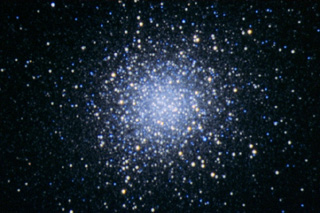
M13 “Hercules Globular Cluster”
| Date |
March 19th, 2006 |
| Filter |
Exposure |
Binning |
| Clear |
5 min 40 sec |
1 × 1 |
| Red |
5 min 20 sec |
2 × 2 |
| Green |
7 min |
2 × 2 |
| Blue |
9 min |
2 × 2 |
M42 Great Orion Nebula
Maybe the most famous nebula on the sky in the constellation
Orion (called “Great Orion Nebula”) can be easily seen by
naked eyes. Capturing this large and bright object on a relatively
small CCD chip is not easy. It was necessary to stack many short
exposure images to minimize CCD chip blooming cause by bright
stars.
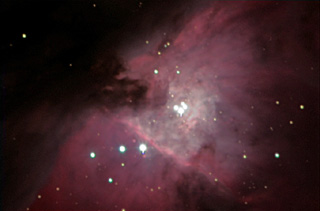
M42 “Great Orion Nebula”
| Date |
January 25th, 2006 |
| Filter |
Exposure |
Binning |
| Clear |
146 s (73 × 2 s) |
1 × 1 |
| Red |
150 s (30 × 5 s) |
2 × 2 |
| Green |
150 s (30 × 5 s) |
2 × 2 |
| Blue |
330 s (33 × 10 s) |
2 × 2 |
M76 Little Dumbbell Nebula
M76 planetary nebula belongs to the fainter Messier objects. It
is also known as “Cork Nebula” or “Butterfly Nebula”
due to its shape. The exact distance of this planetary nebula is
unknown, estimates are between 1,700 and
15,000 light years.
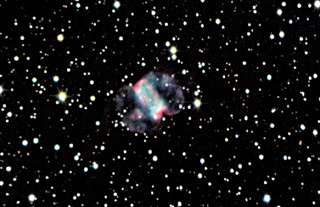
M76 “Little Dumbbell Nebula”
| Date |
January 28th, 2006 |
| Filter |
Exposure |
Binning |
| Clear |
60 min |
1 × 1 |
| Red |
22 min |
2 × 2 |
| Green |
21 min |
2 × 2 |
| Blue |
20 min |
2 × 2 |
M81 Bode's Galaxy
M81 is one of the brightest galaxy on the sky. It is easy to
observe even in small telescope, but its spiral structure can be
revealed only on the photograph or CCD image. The distance of M81
is 11.0 million light years.
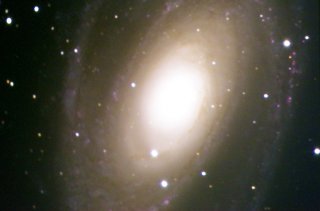
M81 Bode's Galaxy
| Date |
January 28th, 2006 |
| Filter |
Exposure |
Binning |
| Clear |
61 min |
1 × 1 |
| Red |
40 min |
2 × 2 |
| Green |
41 min |
2 × 2 |
| Blue |
40 min |
2 × 2 |
M82 Cigar Galaxy
M82 can be spotted very close to much bigger M81 galaxy. It
passed even closer to heavier M81 in history and the gravitational
field distorted its structure.
M82 was considered Irregular galaxy, by it is probably spiral
galaxy viewed from the edge. The complicated structure of dark
lanes is caused by the gravitational influence of its heavy
neighbor.
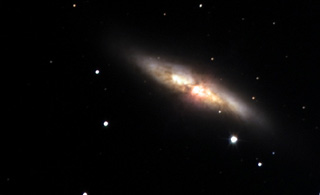
M82 Cigar Galaxy
| Date |
January 28th, 2006 |
| Filter |
Exposure |
Binning |
| Clear |
58 min |
1 × 1 |
| Red |
25 min |
2 × 2 |
| Green |
25 min |
2 × 2 |
| Blue |
25 min |
2 × 2 |
M97 Owl Nebula
The name of M97 planetary nebula—Owl
Nebula—was assigned by Lord Rosse and it
really fits its appearance. Two dark areas resemble big eyes in
the owl head. The central star brightness is 16m. The
distance of this object is uncertain, various authors mention
distances from 1,300 to 12,000
light years.
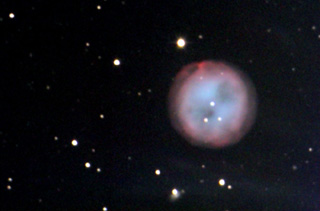
M97 “Owl Nebula”
| Date |
January 27th, 2006 |
| Filter |
Exposure |
Binning |
| Clear |
60 min |
1 × 1 |
| Red |
25 min |
2 × 2 |
| Green |
28 min |
2 × 2 |
| Blue |
61 min |
2 × 2 |
NGC 2392 Eskimo Nebula
Angularly small planetary nebula NGC 2392 was named Eskimo nebula because it
resembles a face surrounded by a hood. It was discovered by
William Herschel in1787. The nebula distance is estimated to
3,000 to 5,000 light years.
The nebula is relatively bright and visible even in small
telescopes, but it is hardly distinguishable from a star when
observed at low magnification—its angular
dimension is only 0.8' × 0.7'. Only
100× and bigger magnification shows
the nebulosity around the central star.
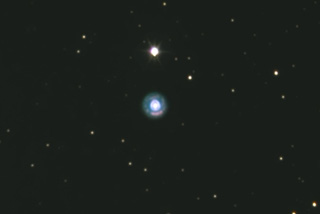
NGC 2392 “Eskimo Nebula”
| Date |
February 27th, 2006 |
| Filter |
Exposure |
Binning |
| Clear |
15 s |
1 × 1 |
| Red |
20 s |
2 × 2 |
| Green |
20 s |
2 × 2 |
| Blue |
20 s |
2 × 2 |
NGC 2419
NGC 2419 is relatively unknown globular cluster in the
constellation Lynx. It is 295,000 light years away
so it appears very small and dim—its
magnitude is only 10.4m and angular
diameter is 4.1 arc min.
Although the following luminance-only image was integrated for
only 18 minutes, it shows stars up to
20m.
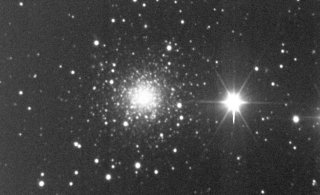
NGC 2419 globular cluster
| Date |
January 25th, 2006 |
| Filter |
Exposure |
Binning |
| Clear |
18 min |
1 × 1 |
All images on this page are courtesy of Kamil Hornoch. Image
processing Kamil Hornoch, Vaclav Pribik, Pavel Cagas.
| 